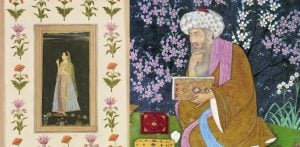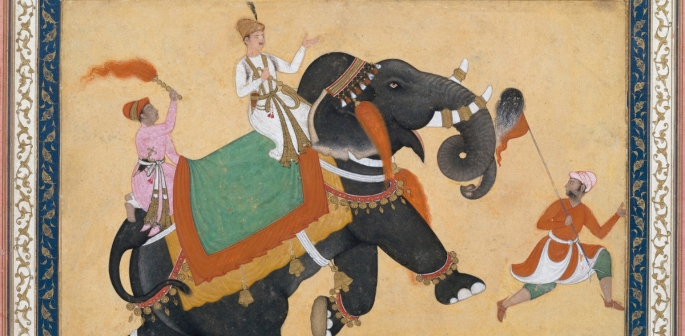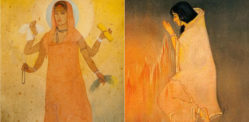The COVID-19 pandemic spurred renewed interest.
India’s artistic heritage is vast and incredibly diverse, a testament to centuries of cultural fusion and innovation.
Yet, amidst the celebrated sculptures and grand architecture, lies a delicate art form often overlooked: Indian miniature painting.
These intricate masterpieces, rich in detail and storytelling, offer a window into the subcontinent’s past.
Once flourishing under royal patronage, this exquisite tradition now seeks renewed appreciation.
This art form’s journey is a compelling narrative of resilience, beauty, and profound cultural expression.
Let us delve into the world of these tiny treasures and rediscover their enduring charm.
Ancient Roots
 The story of Indian miniature painting begins around 750 AD, during the Pala Empire in eastern India.
The story of Indian miniature painting begins around 750 AD, during the Pala Empire in eastern India.
Early artists faced unique constraints, primarily working on palm leaves.
This natural canvas, due to its size, necessitated a small scale for their intricate creations.
These pioneering miniatures predominantly illustrated religious texts, bringing Buddhist manuscripts vividly to life.
Over time, this practice expanded to encompass Islamic and Hindu scriptures, broadening the art’s spiritual scope.
Artists employed remarkable skill, using brushes made from fine squirrel hair for exquisite detail.
They meticulously prepared natural pigments sourced from minerals, vegetables, precious stones, and even shimmering gold and silver.
The Grandeur of Mughal Miniatures
 The Mughal era, spanning the 16th to 18th centuries, witnessed a magnificent flourishing of miniature painting.
The Mughal era, spanning the 16th to 18th centuries, witnessed a magnificent flourishing of miniature painting.
Developed within the opulent Mughal courts, this style was significantly shaped by Persian miniature traditions.
These Persian influences themselves carried echoes of Chinese artistic sensibilities, creating a rich visual blend.
Mughal miniatures are renowned for their stunning realism in portraiture and incredible attention to detail.
Their subjects were diverse, capturing court life, epic battles, thrilling hunting scenes, wildlife, and mythological tales.
This imperial style later permeated other regional courts, influencing both Muslim and Hindu artistic expressions, leading to what art historians term “post-Mughal” and “sub-Mughal” variations, as detailed by institutions like the National Museum, New Delhi.
Rajput Vibrancy
 Emerging from the princely states of Rajasthan between the 16th and 19th centuries, Rajput miniature painting presented a distinct aesthetic.
Emerging from the princely states of Rajasthan between the 16th and 19th centuries, Rajput miniature painting presented a distinct aesthetic.
This style beautifully blended indigenous Indian artistic traditions with sophisticated Persian and Mughal influences.
Rajput paintings are celebrated globally for their strikingly vibrant colours, particularly their bold reds, lustrous golds, and deep blues.
These works showcase complex details and often depict evocative themes drawn from religious narratives like the Ramayana and Mahabharata.
Court scenes, local legends, and romantic sagas also found vivid expression through the Rajput painter’s brush.
Artists meticulously worked on handmade paper, silk, or occasionally even adorned walls with their creations.
Pahari Delicacy
 The term Pahari miniature painting refers to the enchanting styles developed in the lower Himalayan hill kingdoms.
The term Pahari miniature painting refers to the enchanting styles developed in the lower Himalayan hill kingdoms.
Flourishing from the early 17th to the mid-19th centuries, these schools included Basohli, Kangra, Guler, and Chamba, among others.
Pahari miniatures are particularly distinguished by their lyrical quality, graceful lines, and minute detailing.
A prominent focus of this tradition was the divine love stories of Radha and Krishna, alongside other cherished Hindu themes.
Each school within the Pahari tradition developed its own unique stylistic features.
For instance, Basohli is known for its bold, intense colours and distinctive architectural motifs.
In contrast, Kangra paintings are characterised by their delicate lines and refined emotional expression, often praised for their poetic sensitivity.
Techniques and Materials
 Creating an Indian miniature painting is an act of immense patience and painstaking precision.
Creating an Indian miniature painting is an act of immense patience and painstaking precision.
Artists would meticulously layer colours, building up depth and luminosity on their chosen surface.
They added intricate details, often almost microscopic, using extremely fine brushes crafted typically from squirrel hair.
Traditional materials formed the very soul of these artworks, including specially prepared handmade paper or sometimes silk.
The pigments were entirely natural, derived from minerals, plants, and even conch shells, supplemented by the luxurious application of gold and silver leaf.
The process typically involved careful sketching, followed by blocking in base colours, and then the gradual application of finer details, often with symbolic colour usage; for example, red might signify passion or celebration, while gold often denoted divinity or royalty.
Revival and Preservation Today
 Indian miniature painting faced a period of decline during British colonial rule, as Western art styles gained prominence.
Indian miniature painting faced a period of decline during British colonial rule, as Western art styles gained prominence.
However, a significant revival began during the Indian independence movement.
Artists and cultural advocates sought to reclaim and celebrate indigenous artistic traditions.
In contemporary times, artists like Nilima Sheikh and the renowned Singh Twins have masterfully reinterpreted miniature painting.
They skilfully blend traditional techniques with modern themes and even digital media, addressing complex issues of identity and cultural heritage.
Interestingly, the COVID-19 pandemic spurred renewed interest, with artists exploring new motifs and mediums within this ancient framework.
Crucial conservation efforts, including digitisation and restoration by institutions like the Victoria and Albert Museum, London, are vital in preserving these fragile masterpieces for future generations to admire and study.
Indian miniature painting is far more than a relic of the past; it is a living, breathing art form.
Its intricate details, vibrant colours, and profound narratives continue to captivate and inspire.
While it may have been “forgotten” by mainstream discourse for a time, its legacy endures in museums, private collections, and the hands of contemporary artists.
Supporting these artists and institutions dedicated to preservation helps ensure this unique heritage thrives.
By appreciating these tiny marvels, we reconnect with a rich vein of South Asian creativity.
Let us champion this exquisite art and ensure its stories continue to be told for centuries to come.






























































